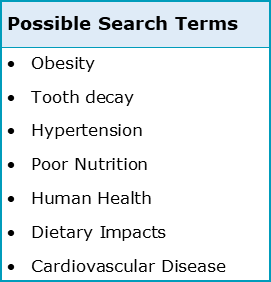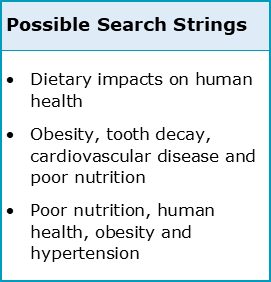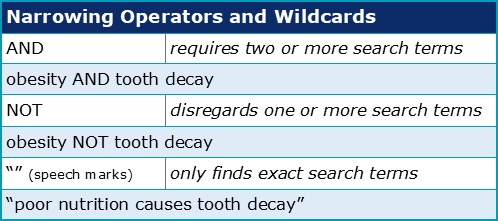How can I narrow or expand academic searches?

This is the second of three chapters about Conducting Digital Searches. To complete this reader, read each chapter carefully and then unlock and complete our materials to check your understanding.
– Introduce the concepts of search narrowing and expanding
– Provide four methods for narrowing an academic search
– Provide four methods for expanding an academic search
Before you begin reading...
-
video and audio texts
-
knowledge checks and quizzes
-
skills practices, tasks and assignments
Chapter 2
While the first chapter on conducting digital searches introduced the general concepts of source digitisation and discussed also where to find academic sources online, this second chapter focuses now more specifically on how to use online search engines (particularly subscription-based ones, such as through an academic library) to find academic sources quickly and efficiently. With millions of sources now stored on the internet, a researcher will, depending on their topics of interest, be required to learn how to both expand and narrow their searches. This is so that they can find more or fewer sources for potential use as evidence within their work.
How can a search be narrowed?
More often than not, when using an online search engine such as Google or a university’s digital library, a researcher will wish to considerably reduce the number of search results presented to them. This is because a keen academic will wish to read through the headings, abstracts and contents lists of a number of sources to further determine if those texts are appropriate (see identifying source value), and it won’t be possible to do this for every source if the search engine has provided thousands of results to sift through. To help you with narrowing your searches, we’ve outlined four methods for you to consider below:
1) Decide Your Focus
Before beginning your online search, it’s most important that you have at least a good idea of the questions you’re trying to answer and how you’re attempting to investigate them. If it’s an essay you’re writing, make sure you fully understand your research question and have brainstormed a number of themes, causes or effects that can be later used to create your search terms. For example, if a student were answering the question “What impact does a poor diet have on a person’s health” in a short essay, they might consider further investigating the following impacts:

If enough evidence or discussion were found about these impacts during a successful search, these ideas could then become the main ideas of an essay’s body section. While it may go without saying, without having themes, topics or main ideas such as these to search for, it will be almost impossible for you to begin a search at all.
2) Use Search Terms
Once you’ve prepared some topics, themes or questions for investigation, you’ll then need to reduce these ideas into short snippets of text called search terms (which can be joined together to create search strings) that can be used to create searches within a search engine. Because search engines tend to ignore certain words when searching, such as the small grammatical terms like ‘the’, ‘a’, ‘of’, etc. that constitute about 25% of all text and are called ‘stop words’, it’s best to reduce your search terms into concise and clear noun phrases.
Returning to our example question about the impacts of a poor diet on a person’s health, below are some possible noun-phrase search terms and search strings that could be used to narrow the search results for this topic:


3) Apply Search Filters
With your search terms and search strings ready, the next step is to open your search engine in preparation for your investigation. It’s worth knowing here that there are a number of filters than can be applied to a library search engine that will help restrict the number of sources you find, although such filters may vary from search engine to search engine. Because of this variation, we’ve included the most common filters for your information below:




4) Use Boolean Operators
Once your filters are correctly applied, you may then wish to include a number of Boolean operators and wildcard symbols with your search terms to narrow your searches even further. While the table below introduces the three operators and wildcards that most effectively narrow a researcher’s search, please note that Boolean operators are explained in much more detail in our third and final chapter:

How can a search be expanded?
For the majority of academic searches, it’s usually much more necessary for a researcher to narrow their search significantly rather than expand it. This is often due to the large volume of sources that may be loosely related to a search topic, particularly for the well-researched themes of ‘diet’, ‘obesity’ or ‘cardiovascular disease’ that were used as examples. Nevertheless, for the more obscure topics that you may find yourself researching in the latter portion of your degree, sometimes the problem is instead that there’s a complete lack of sources and information to assist you when developing your argument. Much like when attempting to narrow a search, there are four key methods that can be used to expand a search when encountering this situation:
1) Use Different Boolean Operators

As can be seen in the previous table, there are a completely different set of Boolean operators and wildcard symbols at your disposal when attempting to expand a search for academic sources, as will be more thoroughly explained in Chapter 3.
2) Adjust Your Search Filters
If the previous operators and wildcards don’t help you find a greater number of sources, you may then wish to adjust the search filters you set earlier in your library search engine. Perhaps try searching for a wider variety of source types or a wider range of publication years, and remember to avoid being too specific about the authors you’re searching for or which library catalogue the sources are contained within. Hopefully a simple readjustment of these filters will increase the number of search results you’re presented with, offering sources that are relevant to your topic.
3) Apply Synonyms to Search Terms
Should steps (1) and (2) fail, perhaps it’s time to return to and reconsider the search terms you created earlier. Are there any related search terms you’ve missed perhaps, or can you add any synonyms (words with similar meaning) to your existing search strings? The search term ‘poor nutrition’, for example, could be expressed as ‘bad diet’ or ‘negative dietary habits’ instead, while ‘human health’ could be written as ‘healthy living’ or ‘the wellbeing of mankind’. Provided these search terms help to expand your search in a meaningful way, it doesn’t matter if the expressions you end up creating sound a little unnatural.
4) Re-evaluate Your Focus
Finally, if none of the above steps help you to locate an adequate number of sources for academic research, you may have to reconsider your overall topic, main ideas and themes. Are there any other ideas you could investigate in your research instead, and is there any flexibility to the overall topic you’re investigating? If not, it may be wise in situations such as this to ask your academic tutor for advice that’s specifically suited to your university, course and assignment.
Having now discussed some of the most effective ways of narrowing and expanding a digital search for academic sources, our third and final chapter on this topic covers in detail how Boolean operators and wildcards can be efficiently used to create effective searches. Keep reading if you wish to learn more.
Downloadables
Once you’ve completed all three chapters about conducting digital searches, you might also wish to download our beginner, intermediate and advanced worksheets to test your progress or print for your students. These professional PDF worksheets can be easily accessed for only a few Academic Marks.
Collect Academic Marks
-
100 Marks for joining
-
25 Marks for daily e-learning
-
100-200 for feedback/testimonials
-
100-500 for referring your colleages/friends